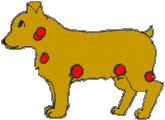The typical canine lymphoma patient is a middle-aged dog brought to the veterinarian because one or more lumps have been found. The veterinarian rapidly determines that these lumps are actually lymph nodes and that many (if not all) of the peripheral lymph nodes (those near the skin surface) are enlarged and firm. Usually the dog has not been showing any signs of illness; he simply has lumps.
The next step is a blood panel and urinalysis to completely assess the patient’s health, and one or more lymph nodes are aspirated or biopsied to confirm the diagnosis of lymphoma.
So here we are.
We know the average life expectancy for a patient with untreated lymphoma is about two months from the time of diagnosis. If this is your dog’s situation, you probably need some time to absorb the cancer diagnosis. You have many general questions and you know that a decision regarding chemotherapy must be made.
We will cover some commonly asked questions owners have at this point.
How did my Dog get Lymphoma?

Most of the time, we do not know how dogs or people get cancer. There are many types of cancer and many possible causes of all those cancers (chemicals in our environment, especially cigarette smoke, sun exposure, assorted viruses and infections). There are important genetic factors as well.
Cancer starts with one or a small group of cells that have gone wrong. Such cells arise in our bodies all the time and we have an assortment of natural mechanisms to destroy these cells before they get out of hand. When these abnormal cells escape our natural mechanisms, cancer develops.
Can my Dog be Cured?
Theoretically, yes, but practically speaking, no. It is best to focus on a realistic outcome that is the longest possible survival with a good quality of life. Different treatment protocols are associated with different disease-free intervals, meaning that the length of time your dog feels normal will vary depending on the protocol you choose. The disease-free interval also depends on patient factors (type of lymphoma, concurrent disease, prior treatment etc.). Obviously, the goal is to have as long a disease-free interval as possible.
Does my Pet Need Further Tests?
Most likely the answer is yes because there is a great deal more to know before treatment options can be determined. We need to know about the state of the patient’s general health and if there are any medications that should not be considered. We need to know what type of lymphocytes are involved. We need to know how far the cancer has spread.Basic blood work and a urinalysis will be needed to assess the patient’s ability to take the medications needed. Obviously liver and kidney function will be relevant, but the blood calcium level is particularly worthy of scrutiny.
Some types of lymphoma produce a hormone called PTH-rp (parathyroid hormone related protein) that is capable of creating dangerous elevations in the blood calcium level. A dog with an elevated blood calcium level tends to have a poorer prognosis. Approximately 15 percent of dogs with lymphoma (and 40 percent of dogs with T-cell lymphoma) have elevated blood calcium levels, so screening is important from the beginning.
If a biopsy has not been performed, it may be a good idea to do one so as to get the maximum information about the tumor (whether it is slow or fast growing, what type of lymphocytes are involved, etc.) as this information can help predict the response to chemotherapy. Special staining of the sample, or even a test such as flow cytometry, is needed to distinguish the type of lymphocyte involved in the tumor. T-cell lymphoma, for example, is less responsive to medication than B-cell lymphoma. Luckily, B-cell lymphoma accounts for 75 percent of canine lymphoma.
Other tests that may be recommended include a bone marrow aspirate, ultrasound of the abdomen, and/or a spleen or liver aspirate. These tests are needed to stage the disease, which basically means determining how widespread the cancer is in the body. Lymphoma is classified by stage:
Stage I: only one lymph node involved
Stage II: several lymph nodes in the same general area involved
Stage III: all peripheral lymph nodes involved
Stage IV: all peripheral lymph nodes plus the spleen, liver, and/or anterior mediastinum in the chest involved
Stage V: bone marrow involvement, regardless of any other areas involved
Staging has less impact on therapy choices than one might think but it is true that patients in Stage V, the most advanced stage, have a poorer prognosis than those in the other stages.
How does Lymphoma Cause Death?
Lymphoma is a rapidly growing malignancy that is able to arise and/or travel to anywhere where there is lymph tissue. Of course, there is lymph tissue in virtually every organ in the body. Eventually, the cancer will infiltrate an organ to such an extent that that organ fails (often this is the bone marrow or the liver). The patient loses appetite, vomits or gets diarrhea, weakens and dies. At some point the tumor becomes resistant to therapy and no further remissions can be obtained.
My Dog does not Fit the Above Scenario at all. What are other Forms of Lymphoma?
Lymphoma is classified by the anatomic area affected. By far, the most common form in dogs is the multicentric form, which accounts for 84 percent of canine lymphoma. In this form, as in the hypothetical case we opened with, all peripheral lymph nodes are large and firm. There are three other forms of lymphoma:
- Gastrointestinal form (affecting only the GI tract) accounts for 5-7 percent of canine lymphoma
- Mediastinal (chest)
- Extranodal (skin, eye and other miscellaneous areas).
Lymphoma can occur anywhere in the body where there is lymph tissue. At this time, we will concentrate on multicentric lymphoma. Eventually further information on these rarer forms will be added.
Chemotherapy FAQ
The word chemotherapy conjures images of people losing their hair and suffering chronic nausea. It is unfortunate that many pets do not receive chemotherapy based upon these unpleasant images that do not truly represent the current state of treatment response in pets. Chemotherapy simply means therapy using medication (as opposed to using surgery or radiation). Decades of research has gone into patient comfort, minimizing side effects and maximizing response so it is important to keep an open mind. The following are common questions pet owners commonly have regarding chemotherapy for their dog.
The median survival time for most dogs on chemotherapy is approximately one year with 25 percent of dogs surviving two years.
My dog is not acting sick in any way. Shouldn’t I wait until she at least feels sick before beginning chemotherapy?
This might seem like a reasonable approach at first glance but let us assure you that it is not. One of the most important factors in determining the quality of remission (i.e., how fast we get remission and how long it lasts) is whether or not the patient is feeling sick at the time chemotherapy is started. When lymphoma patients are staged (see above under “does my pet need further tests?”), stages are subcategorized as a or b, depending on whether or not the patient is feeling ill or not. For example, a multicentric lymphoma dog who feels well is in stage IIIa compared to one who is vomiting or not eating is in stage IIIb. You will have a much better chance for long-term quality survival if lymphoma is treated while the patient is an a.
Are there other factors that might suggest a better or worse response to treatment?
The goal is to achieve remission quickly and for the longest possible time. Factors that contribute to an individual dog’s ability to do this include:
- Whether he is feeling sick at the time treatment is started. (Dogs that do not feel ill do best).
- Whether there is hypercalcemia (elevated blood calcium) on the blood panel. (Dogs with hypercalcemia do worse).
- Prior exposure (within the last week or so) to corticosteroid medications. (Steroids make the tumor resistant to chemotherapy – see below).
- Whether the lymphocytes involved are B-cells or T-cells. (T-cell lymphoma is more difficult to treat than B-cell lymphoma.)
- Whether there is intestinal involvement. (Intestinal lymphoma is very bad news for a dog.)
- Having Stage V lymphoma. (Most stages carry similar prognoses but Stage V is extra bad.)
- Indolent forms of lymphoma, small cell lymphoma, and low-grade lymphoma progress very slowly but are more resistant to chemotherapy.
Should we see an oncologist?
Lymphoma is a condition that not all veterinarians are comfortable treating. Discuss with your veterinarian whether referral to a specialist would be best for you and your pet.
Will chemotherapy make my dog sick?
Probably not. Nausea and infection are possibilities but most dogs do not experience any such complications. Only 7 percent of patients require hospitalization due to side effects of chemotherapy. The bottom line here is to know that animals rarely get sick from chemotherapy but that you should know what to do in case of a problem (see later).


